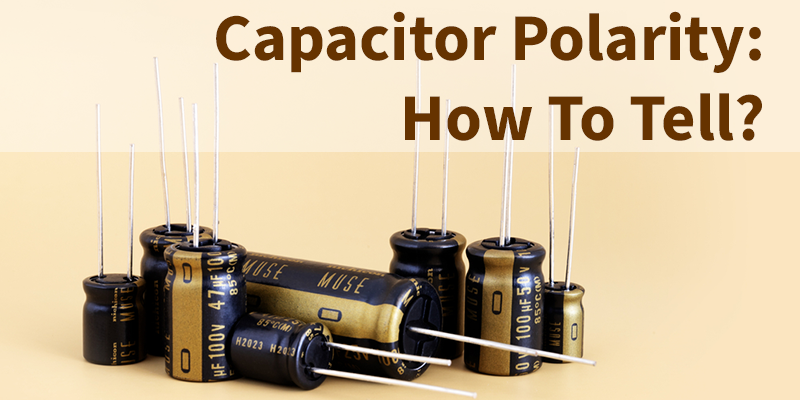The existence of polar and non-polar capacitors rises from their differences in the dielectric material between the plates used to store charges. The dielectric material in non-polar capacitors diffuses the positive and negative charges evenly, whilst in polar capacitors, the positive and negative charges are each separated toward a pole.
Utilizing the two types of capacitors are very much the same, except for the fact that polar capacitors must be positioned in only one orientation, due to their polarity. Non-polar capacitors, such as film and ceramic capacitors, on the other hand, could be positioned the other way around too.
Electrolytic capacitors are the general type of polar capacitors present in the market. The placement of polar capacitors might be a little tricky since the polarity should be paid attention to. There are several methods in identifying the polarity of a polar capacitor, including:
- Visual Identification
- Use of Multimeter
I. Visual identification
The polarity of a capacitor can be visually identified without the use of a multimeter using some of the common methods, which include as follows:
1. The Polarity of Radial Electrolytic Capacitors
The housings of the radial electrolytic capacitors are mainly in black-gray or green-black color, with two pins of different lengths. These characteristics, the color and pin length of the capacitors could be used as a method of polarity identification.
Here, the longer pin denotes the positive pole (i.e. the anode), and the shorter pin denotes the negative pole (i.e. the cathode).
Identifying through the colors, the black (in black-gray combination) or green (in green-black combination) part of the housing refers to the anode of the capacitor, and the gray or black (in green-black combination) part indicates the cathode.

Black-gray Radial Electrolytic Capacitor
2. The Polarity of Tantalum Capacitors
A typical tantalum capacitor is polarized and has positive and negative poles. The component is usually yellow colored and is designed to be surface mounted on the circuit board. On the surface of the housing, an end marked in-dash denotes the positive pole, and hence the negative pole is at the other end.

Tantalum Capacitor
Tantalum capacitors’ polarity identification technique is similar to those of SMD diodes. However, it is to be noted that a marked end of a diode denotes the negative pole, which is the opposite of that of the Tantalum capacitor.
3. The Polarity of Aluminum Electrolytic Capacitors
Aluminum electrolytic capacitors are generally colored by mainly the color grey. The capacitor has also been geometrically configured, has different sides with right-angle corners and trapezoidal corners which also serve as a polarity identification.

Aluminium Electrolytic Capacitor
The gray-colored side represents the positive pole (anode), and the black part indicates the negative pole or the cathode. With this, the pin corresponding to the right-angle base edge refers to the cathode, and the pin corresponding to the trapezoidal edge refers to the anode.
II. Use of Multimeter
Despite the ease of telling a capacitor’s polarity by its appearance, some might not know or are unsure of the identifying characteristics. Therefore, it is a common practice to identify the polarity of a capacitor with a multimeter. By using professional equipment, we can ensure the precision of the results.
It is basic knowledge that the current passing through an electrolytic capacitor is small (i.e. large leakage resistance) when its anode is connected to the power supply’s positive pole (a multimeter’s black pen for resistance measurement) and the cathode is connected to the power supply negative (multimeter’s red pen). Otherwise, the leakage current of the electrolytic capacitor will be high.
Testing method using a multimeter:
- For measurement, we first assume one pin is the anode, to be connected to the black pen of the multimeter, then connect the other pole to the red pen of the multimeter.
- Take the reading at which the pointer stops (the higher value in the left part of the pointer). For measurement, preferably set the reading at R*100 or R*1K.
- Discharge the capacitor (to remove any stored charges) and then exchange the two multimeter pens for measurement again.
- Out of two tests, the test in which the pointer stops on the left side (higher resistance value) indicates that the pole connected to the black pen is just the anode of the electrolytic capacitor.
Notes:
- Use a resistor or an additional wire to discharge the possible residual electricity of the capacitor before taking any measurement;
- As the measurement is a charging process, it will take some time until the reading is basically stable
- The black pen of a meter is the positive and the red pen is the negative, while it is the opposite for a digital meter.
Here are a few ways on identifying the poles of a capacitor. Remember to connect the anode (positive pole) of the capacitor to the respective positive pole of the power source. Only by this, the circuit can be completed and the capacitor can operate as expected.


